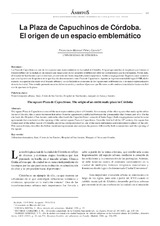La Plaza de Capuchinos de Córdoba. El origen de un espacio emblemático
Autor
Pérez García, Francisco Manuel
Editor
Asociación de Estudios de Ciencias Sociales y HumanidadesFecha
2014Materia
Transformación urbanaSiuri Navarro, Marcelino, 1654-1731
Cristo de los Faroles
Hospital de San Jacinto
Marqués de Ariza y Armiño
Urban transformation
Marquis of Ariza and Armiño
METS:
Mostrar el registro METSPREMIS:
Mostrar el registro PREMISMetadatos
Mostrar el registro completo del ítemResumen
La Plaza de Capuchinos es uno de los espacios más representativos de la ciudad de Córdoba. Al igual que muchas de las plazas que forman el trazado urbano de la ciudad, es un espacio que surge a raíz de los acuerdos establecidos entre las comunidades que la configuran. Por un lado, el hospital de San Jacinto y por el otro lado, el convento del Santo Ángel de padres capuchinos. Ambas congregaciones llegaron a unos acuerdos que concluyeron con la apertura de lo que hoy día denominamos como Plaza de Capuchinos. A partir de la primera mitad del siglo XVIII, dicho espacio va a quedar plasmado en el trazado urbano y va a ir forjándose como uno de los lugares más emblemáticos y de mayor representación de toda la ciudad. Este estudio pretende mostrar dichos acuerdos y analizar el proceso que llevaron a cabo ambas comunidades hasta concluir con la apertura de la plaza. The square Plaza de Capuchinos is one of the most representative places of Córdoba. Just as many of the other squares that make up the urban layout of the city, this is an environment that arises from the agreements established between the communities that formed part of it. On the one hand, the Hospital of San Jacinto; and on the other hand, the Capuchin Friars’ convent of Santo Ángel. Both congregations reached to some agreements that concluded on the opening of the current square Plaza de Capuchinos. From the first half of the 18th century, this square has formed part of the urban layout of Córdoba, and it has configured itself as one of the most emblematic and representative places of the city. This research study describes the before mentioned agreements and analyses the process followed by both communities until the opening of the square.

